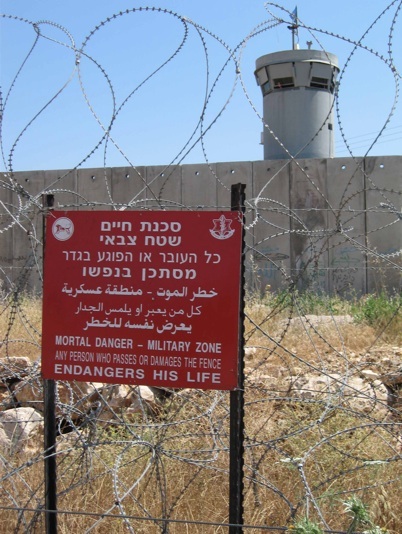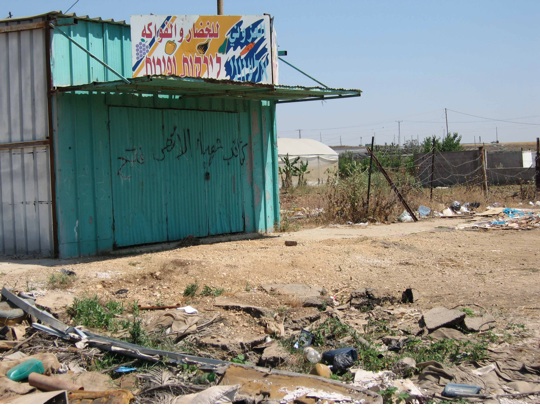A group of us activists went to Qalqilya, a town so far west that it sits not in the dry hills, but on the humid coastal plane. Though the uprising had been effectively suppressed, we felt that our trip, in solidarity with the Palestinian struggle, was important. After all, the violence and dispossession of the occupation had not ceased even though the resistance had been decimated.
Our solidarity group was warmly received by local activists who were quite used to seeing similar delegations from Europe and the US. They took us to the massive concrete wall, complete with guard towers every few hundred yards. We couldn’t believe it, though we’d read about it, and had seen dozens of pictures of it before we decided to come here.

We took pictures of ourselves and each other, and our guides, beside the wall which was covered by graffiti from earlier solidarity delegations before us. We even recognized one slogan that a friend of ours from back home must have painted. I took a picture of one of our friends beside it to send to him over the internet.

We visited the father of two youths who’d been killed in 2002 and 2003. He told us the story of how they’d been killed. The first in a firefight with an Israeli patrol, the second as he tried to bomb a checkpoint, though he was shot before he could get close enough to hurt Israeli soldiers. We recalled that our friends, who visited here a year ago, had told us the same story when they gave their teach-in back home. At one point, we became self-conscious of the fact that we were taking the exact same tour our friends had taken before us. We realized that the questions we directed at the martyrs’ father were questions he’d heard hundreds of times before. As we asked to pose with the man, I realized I’d seen an earlier version of this same picture, in the same courtyard under the same grape arbor.
They took us to another place and showed us a map that showed how the wall and the electrified fence surrounded the city on all sides. They pointed out the Jewish-only settlements on the map, then showed us how they appeared on the hills surrounding the city. They showed us the narrow tongue of land, only a couple hundred meters wide and bounded by electrified fences and concrete military posts, was what connected the city to the rest of the West Bank. We looked from the map to the landscape and back again and understood how the system of control worked. We could see with our own eyes that there was a plan behind the developments we could see taking place. We knew it from books before, but now we were experiencing it directly.
Someone commented how the wall made the city resemble the Warsaw Ghetto, we nodded, though we weren’t quite sure since we`d never seen it. Someone else commented that the occupation had turned the city into an inside-out medieval fortress. We imagined archers stationed on the outside looking down at us through narrow slits in the towers, and cauldrons of burning oil ready to pour down on the city inside. Before this, we may have imagined what a siege was, but now we knew.

Other Palestinians replaced our first guide and took us to one of the nurseries that the city used to be famous for. As we sat under the shade of a white mulberry tree, they pointed out how the electronic fence had separated them from many of the hothouses, nurseries and orchards that they owned. We looked closely and could see that many of the fruit trees were dying from neglect on the other side of the fence. Others appeared to have been tended by new Jewish owners. To see this taking place as we sat there drinking tea and watching the mulberries fall made us feel helpless and angry.
Since our guides had another group to meet, they dropped us off downtown. Waiting for the next bus, we walked through the main street, and past the first traffic light we’d seen in Palestine. The street signs were as often as not in Hebrew as they were in Arabic, and we were reminded how this used to be a border town where Israelis went to buy products for cheaper prices. We were taking pictures of the posters and slogans we saw on the walls of the town and realized that most of the stores were closed. We understood again how killing the commerce of a city might induce its inhabitants to leave for good, which was what was happening in the city. After seeing it with our own eyes, there was no doubt in our minds that it was a slow-motion form of ethnic cleansing. We could see how it worked by its irreversible effects, how it could take place without there being always copious amounts of bloodshed. Someone added, "But there is that, too."
Somehow, we got separated from the rest of the group, and found ourselves invited into a shop for tea. We sat down and talked to the young men who wanted to know where we were from and what we were doing there. We told them about our solidarity and they made a phone call to someone. We continued sitting there as they asked us questions about why our government hated them so much, why our government hated Muslims so much and so on. We corrected them, and told them it was not just our government they had a problem with. We told them that our government was a democracy, that it represented the will of its people, and that it was naïve to distinguish the policies and actions of an elected government from the will of its people. "If our government is to blame, we are to blame," we told them. They shrugged and said, “Perhaps.”
A young man arrived and immediately engaged us in debate. He wanted to know where we were from and what we were doing there. We told him about our solidarity. He then told us this:
There was a city on fire. People in the city were unable to put the fire out. Many were burned, and many died from their burns. This alarmed people in neighboring cities. And they came to see what was happening in the city on fire. These visitors took pictures and talked about how awful the fire was. They offered comfort to the victims of the fire. They rebuilt sections of the city that had been burnt. Others went closer to the flames, wanting to touch them to see what it felt like to burn. They came and went, taking pictures, telling stories. Despite all the delegations, the fire continued to burn.
The man then wished us good day and walked away without shaking our hands. We found the rest of the group and left Qalqiliya on the next bus. We promised among ourselves to stay in touch with the people we’d met and to tell our community everything that we had seen and heard.
[Earlier installments of this series can be found here, here, here, here, and here.]